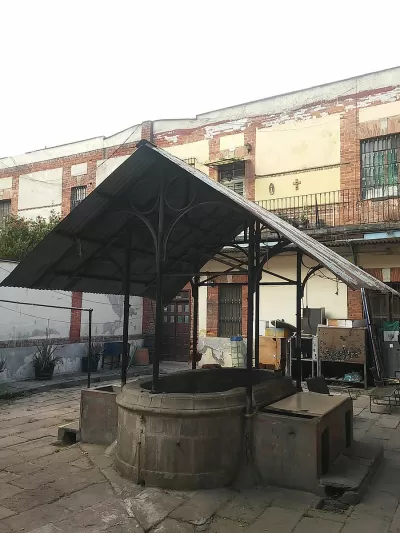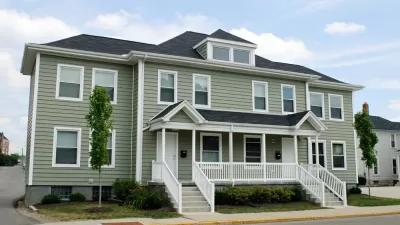An iconic multifamily housing form repurposes the former homes of Mexico's elite into communal housing for urban workers.

In an article series exploring iconic home designs around the world, Natalie Delgadillo describes an urban Mexican housing type known as a "vecindad." Although the word technically means "neighborhood," it has come to define a specific design: "a kind of tenement where individual apartments encircle a central patio, and residents often share facilities such as bathrooms and kitchens."
The vecindad, Delgadillo writes, is an appropriate symbol of the country's colonial past, having started life as an imposing home for aristocratic Spanish families before being subdivided into dwellings for the working class. "The history of these structures in Mexico City is rich and deep; they tell a story about the city’s development into a megalopolis, not to mention the country’s myriad — and sometimes seismic — economic and political shifts from the 17th century onward."
As rural Mexicans migrated to cities in search of work in the 19th century and the wealthy moved to the suburban periphery, the buildings were repurposed as multifamily rental units. They at first lacked private amenities like bathrooms or kitchens, though some have been added more recently. The central patio linked the residents for essential tasks, creating a "deeply communal way of life."
Delgadillo describes the complex and nuanced social relations created by the intimate nature of the vecindades and the intricate hierarchies developed among their inhabitants. According to the article, the vecindad gained a cultural cache that has left a powerful imprint on the Mexican imagination. But today's vecindades have fallen into disrepair, writes Delgadillo, damaged by earthquakes and decades of neglect from policymakers and planners who prioritized newer housing types. Now, despite some restoration efforts, the future of vecindades as a source of housing for low-income families is threatened as the buildings get converted to other uses or more expensive housing.
FULL STORY: How Mexico City’s Vecindades Became Homes for the Working Class

Study: Maui’s Plan to Convert Vacation Rentals to Long-Term Housing Could Cause Nearly $1 Billion Economic Loss
The plan would reduce visitor accommodation by 25,% resulting in 1,900 jobs lost.

Alabama: Trump Terminates Settlements for Black Communities Harmed By Raw Sewage
Trump deemed the landmark civil rights agreement “illegal DEI and environmental justice policy.”

Why Should We Subsidize Public Transportation?
Many public transit agencies face financial stress due to rising costs, declining fare revenue, and declining subsidies. Transit advocates must provide a strong business case for increasing public transit funding.

Paris Bike Boom Leads to Steep Drop in Air Pollution
The French city’s air quality has improved dramatically in the past 20 years, coinciding with a growth in cycling.

Why Housing Costs More to Build in California Than in Texas
Hard costs like labor and materials combined with ‘soft’ costs such as permitting make building in the San Francisco Bay Area almost three times as costly as in Texas cities.

San Diego County Sees a Rise in Urban Coyotes
San Diego County experiences a rise in urban coyotes, as sightings become prevalent throughout its urban neighbourhoods and surrounding areas.
Urban Design for Planners 1: Software Tools
This six-course series explores essential urban design concepts using open source software and equips planners with the tools they need to participate fully in the urban design process.
Planning for Universal Design
Learn the tools for implementing Universal Design in planning regulations.
Smith Gee Studio
Alamo Area Metropolitan Planning Organization
City of Santa Clarita
Institute for Housing and Urban Development Studies (IHS)
City of Grandview
Harvard GSD Executive Education
Toledo-Lucas County Plan Commissions
Salt Lake City
NYU Wagner Graduate School of Public Service





























